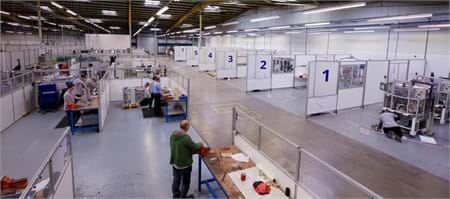Manufacturing industry in the UK and overseas depends on a supply chain of SMEs providing components as well as the machinery used to build and test their specific products.
These secondary producers in turn require the services of companies such as Pirtek to construct aspects of their kit. As such, Pirtek Plymouth was called upon to design and integrate the hydraulic pipework and hose sets on a test machine designed and built by control and automation specialists Applied Automation, for a major primary producer in the automotive industry.
Based in Plymouth, Applied Automation Ltd. designs and manufactures bespoke solutions for automation and control in industrial engineering. It has a wealth of experience providing innovative solutions to a broad range of sectors including automotive, pharmaceutical, marine and transport as well as smart homes, supplying companies across the UK and around the world.
The company employs more than 150 designers, engineers, project managers, sales engineers and professional specialists.
“We’re in a creative game,” says Mark Redsell, senior design engineer at Applied Automation Ltd. “We spend our lives creating engineering solutions to automate mechanical assemblies and processes.”
Applied Automation Ltd. was asked by a major automotive manufacturer to design and supply a machine to run a set of accurate pressure and flow tests on an engine component. In addition, this part was to be secured by a mechanism to simulate the “in-vehicle” sealing assembly, with nine fixture points, each exerting up to one tonne of clamping force.
A similar application had previously used a single hydraulic press exerting the required clamping load evenly across the component. This may have been a simpler mechanism but due to space constraints, the need to more accurately simulate the in-vehicle loading and to provide easy access for both operator loading and future routine maintenance, a new design was required. So based on the customer’s brief, Applied Automation designed and built the bespoke Functional and Final Test Machine.
As part of the clamping system, Applied Automation contracted Pirtek Plymouth to design and integrate the hydraulic pipework.
As well as accuracy, ease of use comes into the design of both the machine itself and the hydraulic circuitry that make it work.
Mark explains, “Ergonomics is an important part of a machine design. Access for the operator loading (heights and reach), are critical. You can’t have obstructions or sharp edges, etc.
The same considerations apply from Pirtek’s point of view.
“It wasn’t just a case of supplying the hydraulic pressure lines,” says Lee Dommet, Pirtek MSST. “It was also routing it correctly, keeping within the restrictions, keeping the powerpack within the footprint etc. Factory floorspace is at a premium.”
The design of the machine meant there were only so many ways in which Pirtek’s man could run the hoses.
Mark explains, “We’ve got moving tooling, cameras and sensors all over the machine. The cameras can’t have pipework in their way, so Lee had to go around those, while also making the pipework integration aesthetic and functional.
“I am a great believer that if someone has to stand next a machine all day, every day, if you can make that machine ergonomically pleasing in design, it makes their life easier and happier.”
The Functional and Final Test Machine has two sets of change tooling, with the hydraulics split into two supply circuits.
Mark elaborates, “We decided to route it from the back and round the sides to keep it out of the way of the operator and allow a more natural loading into the test bed.
“The huge benefit of our new concept – in this case, replacing the single circuit press with nine individual rotational hydraulic clamps – is that it takes all the tooling away from the line of sight of the operator. The clamps are smaller, with more localised guarding, so it’s safer too.
“I gave the brief to Lee – quick release couplings at the rear, with the piping to enter through the machine in two circuits, either side of each tooling set. Then I let him get on with it. You saw what he ended up with – it’s like a work of art really.”
Pirtek’s MSST waxes lyrical about the job. “It certainly tested a few years of experience. I’ve never done the same machine design twice, so every day you get up and you’re answering new questions.
“You get guys on the shop floor saying, ‘I’ve got a problem with this, how do I route this?’ As the technician, you’ve got to adapt to that.”
The machine involves complex shapes with narrow paths and tight angles.
Mark says, “We have to get pipework into various areas within a three-dimensional space. Because you’re doing high accuracy flow testing, you don’t want too many right angles in the pipes as it creates ‘K-values’ – denoting restrictions in the flow of the air (both from pressure and vacuum sources), through the pipes.
“In an ideal world you’d want all the pipes to be straight, but in the real world we have to get all these complex pipes into an enclosed space. With regards to the flow test circuits, we decided to also route them in hydraulic hose, as it will not expand or pant under the flow pressures being run and you also naturally get smooth bends and arcs because of its rigidity.
“If you tighten the radius of the curve it can affect the test results. The machine needs to run a set of incredibly sensitive tests.”
The two sets of quick-change tooling are fitted onto removable beds, so that they can be easily uncoupled and removed from the machine.
“The sets of tools get pulled out of the back and you bring two more sets in,” explains Mark. “Each toolset weighs up to half a tonne.
“Everything is quick release,” he says, “with the hydraulic quick release couplings at the rear.”
Pirtek Plymouth’s MSST obviously enjoyed the project. “The whole job has been quite a challenge. It’s the type of job that I like doing, where you can get stuck in.”
“With Lee’s work the most important thing is the ergonomics,” says Mark. “He designed circuits that were clean, tidy and out of the way.”
Mark and Applied Automation are clearly very happy with Lee’s work and with the MSST’s attitude, it’s not hard to see why.
“You have to take pride in your work,” Lee says. “You put your name to it. This is what we do! If you have a good relationship with your customer, you’ll certainly get more business.”
Mark shares Lee’s attitude to relationship building. “We like to think we build up long term relationships with our customers and suppliers. If I want a similar job done, why would I talk to anyone else?
“It’s twofold – they know their industry better than we do. My opposite number on site might say, ‘We have a machine that does something similar and this is how we do it.’ You then share and develop ideas. From what we’re doing here, the customer may sometimes comment, ‘Actually that’s a neat way of doing that.’
“Sometimes you get an idea from people who aren’t mechanically minded – it can even be an advantage! Finding a solution can be as simple as turning a process upside down – gravity’s free.
“You’re learning all the time. We’re not arrogant enough to think we know the best way.”
Lee interjects. “It’s about the buzz you get when you find a solution to a problem – job satisfaction. If you don’t get that, you’re in the wrong job.”
“It’s the hard projects that you remember and have pride in,” says Mark, “The easy ones generally get forgotten. We always solve the problem, we always get there, it’s just that sometimes there’s a bit more trouble on the way.”
Mark continues, “There’s no creative person who hasn’t failed yet. If you’re someone who’s never failed or never had a design not go quite right, you haven’t pushed the boundaries. We get quite hard skinned about that. That’s how we accumulate knowledge. It’s a kind of engineering evolution really.
“You build up that experience over time. What we also tend to do here is have a very open shop floor approach. We don’t close the door to the customer and say, ‘You’re not welcome until the machine’s finished’. We encourage them to visit and understand the process and machine build with us. The customer hand-over is always more seamless then.”
Mark explains a little more about the process.
“The customer comes to us with a specification. We have a concept, how we perceive the machine to be. As time goes by, it evolves mechanically. The control hardware engineers then design the circuits controlling the electrics, pneumatics and hydraulics. On the back of that, the software engineer then adds his ‘leaves to the branches’ to bring the machine to life and before you know it you’ve got the ‘tree’. But it generally all starts with a blank piece of paper.
“That’s true of every machine we do.”
The end result is satisfaction for the end user, manufacturer and for Pirtek as integrator of the hydraulic element.
“When this machine was first assembled and powered up, it literally just went click, click, click… just as it should,” says Mark. “So you think – I’ve just sweated over that for three months and when we turned it on there’s no drama.
“Actually, I like anticlimaxes. When you’re dealing with nine tonnes of pressure on intricate tooling, I’ll take an anticlimax any day!”
Lee concludes, “When you get the callback, you know your last job must have been good.”






Select a country